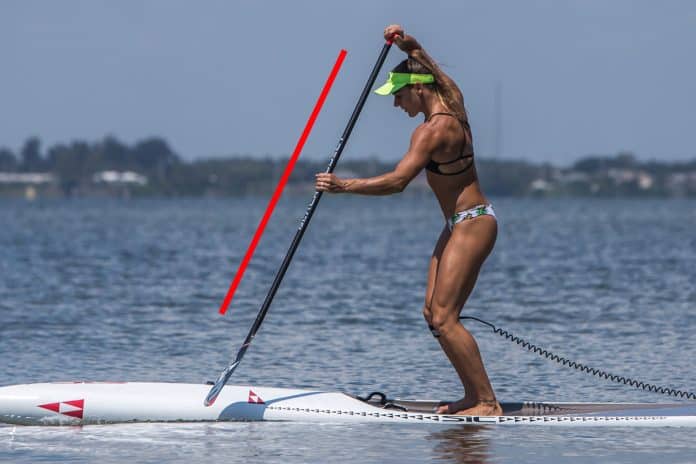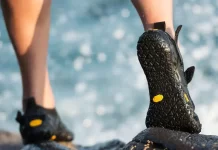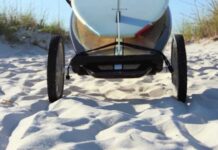You’ve come to the right place if you’re new to stand-up paddleboarding (SUP) and eager to navigate the waters with grace and finesse.
In this article, we’ll uncover the ultimate SUP paddle stroke technique tailor-made for beginners seeking to conquer the art of paddling. We’ll empower you to glide across the water’s surface confidently and efficiently by breaking down the essential elements and providing expert tips.
So grab your paddle, brace yourself for an exciting journey, and let’s embark on the quest to master the perfect SUP paddle stroke technique.
The Basics of SUP Paddle Stroke
Understanding the SUP Paddle
Regarding stand-up paddleboarding (SUP), the paddle is a crucial tool that allows us to maneuver through the water. Understanding the different components of the SUP paddle is essential before we delve into the various stroke techniques. The paddle typically consists of a blade, shaft, and handle. The size and shape of the blade can affect the efficiency and power of our strokes, while the length and material of the shaft determine its flexibility and durability. Familiarizing ourselves with the paddle ensures that we can use it effectively and adapt to different paddle stroke techniques.
Grip Techniques
Choosing the correct grip technique is another crucial aspect of developing a solid SUP paddle stroke. Different options exist, such as the “T-grip” and the “palm grip.” The T-grip involves holding the handle with our dominant hand while resting the other hand on the paddle’s shaft. Conversely, the palm grip entails gripping the paddle handle with both hands. Finding a grip that feels comfortable and allows for a secure hold on the paddle is essential, ensuring we can maintain control and power throughout our strokes.
Body Alignment
Proper body alignment is critical to achieving an efficient SUP paddle stroke. Maintaining an upright posture with a slight forward lean helps distribute our weight evenly on the board, enhancing stability and maneuverability. We can stabilize our body and maintain balance while paddling by engaging our core muscles. Keeping our shoulders relaxed and parallel to the board allows for a more fluid and controlled stroke. Good body alignment sets the foundation for effective paddle strokes and reduces the risk of strain or injury.
Getting Started with the Forward Stroke
Feet Positioning
Placing our feet in the correct position on the board is essential for stability and control during the forward stroke. We should stand with our feet shoulder-width apart, allowing us to maintain balance and distribute our weight evenly. By placing our feet further apart or closer together, we can adjust our stability and maneuverability based on the conditions and our skill level. Experimenting with different foot positions will help us find the optimal stance for our forward strokes.
Hand Placement
Where we place our hands on the paddle directly affects the efficiency of our forward stroke. To achieve proper hand placement, we need to hold the paddle with our hands slightly wider than shoulder-width apart. This positioning allows us to generate more power and control, enabling us to propel ourselves forward with each stroke. As we progress, we can experiment with hand spacing, finding the most comfortable position and maximizing our performance.
Engaging Your Core
Engaging our core muscles is crucial for maintaining stability and generating power in paddle strokes. By contracting our abdominal muscles and keeping our core strong, we create a solid foundation to push against the water with each stroke. A strong core also helps with balance and agility on the board. When initiating the forward stroke, focus on using your core to propel yourself forward, allowing your arms and shoulders to work harmoniously with your abdominal muscles.
Entering the Water
Once we are in the correct stance and firmly grip the paddle, it’s time to focus on entering the water smoothly. The paddle blade should be fully submerged, with the entire blade perpendicular to the water surface. By immersing the blade fully and evenly, we maximize the efficiency of our stroke, gaining more propulsion. Practicing and becoming comfortable with this movement will lead to smoother and more effective paddling.
Pulling Phase
The pulling phase of the forward stroke is where we generate most of our power to propel ourselves forward. As we begin pulling, our lower hand should extend toward the nose of the board, initiating the stroke and using our core strength to generate power. The upper hand acts as a pivot point, providing stability and control. Pulling the paddle through the water, we can rotate our torso slightly to engage our core muscles fully. This rotation adds extra power to the pulling motion and allows for a smoother stroke.
Recovery Phase
After the pulling phase, we enter the recovery phase, bringing the paddle blade out of the water and preparing for the next stroke. This phase is as crucial as the pulling phase, setting the rhythm and timing for our paddle stroke. As we recover the paddle, keeping our upper arm reasonably straight is essential, allowing for a smooth movement out of the water. Bringing the paddle too far back or forward can disrupt our balance and efficiency. Practice finding a fluid and natural recovery motion to maintain a steady rhythm and conserve energy.
Common Mistakes to Avoid
When learning the forward stroke technique for SUP paddleboarding, beginners often make common mistakes. One of the most common errors is gripping the paddle too tightly. Remember to relax your grip to prevent fatigue and allow a more natural and fluid stroke. It is also essential to avoid excessive leaning or overreaching with our strokes. Maintaining an excellent and balanced posture helps prevent strain on our shoulders and back. Finally, be mindful of not rushing through the different stages of the paddle stroke. Each phase should have a controlled and deliberate movement to maximize efficiency and power.
Mastering the Turning Stroke
Sweep Stroke
The sweep stroke is a fundamental technique for turning our SUP board efficiently. To execute a sweep stroke, we reach out with our lower hand and place the paddle’s blade near the front of the board. Using our core muscles, we sweep the paddle blade in a wide arc away from the board, creating a smooth turn. This stroke is especially effective when executing sweeping turns or navigating tight corners—practice incorporating the sweep stroke into your paddling routine to become more versatile and agile on the water.
Backward Paddling
While it may seem counterintuitive, backward paddling is a vital skill to master for effective turning and maneuvering. To paddle backward, we reverse the motion of our forward stroke, pushing the paddle away from our body as we pull it through the water. This technique allows us to maintain control and adjust our positioning when necessary. By becoming proficient in backward paddling, we can easily navigate tricky situations and confidently adjust our direction.
Pivot Turn
The pivot turn is a more advanced turning technique that involves using our paddle as a pivot point to execute a swift and controlled turn. To perform a pivot turn, we grip the paddle securely and place the blade perpendicular to the water surface. By applying pressure to the paddle and using our body weight, we pivot around the paddle, creating a quick and tight turn. This technique is beneficial when navigating narrow waterways or making rapid directional changes. Proper execution of the pivot turn requires practice and coordination, but mastering this technique can significantly enhance our maneuverability on the board.
Improving Efficiency with the Reverse Stroke
Hand Positioning
The reverse stroke, or backstroke, is valuable for slowing down, stopping, or moving backward. To execute a reverse stroke, we must correctly position our hands on the paddle. Unlike the forward stroke, where our top hand is gripping above the lower hand, the reverse stroke requires us to grip the paddle with our lower hand above the top. This reversed hand positioning enables us to pull the paddle toward our bodies, effectively generating the power and resistance to paddle backward.
Initiating the Stroke
Initiating the reverse stroke involves pushing the top hand away from our bodies and the bottom hand towards our bodies. This motion propels the paddle blade through the water, generating resistance for backward movement. As with the forward stroke, engaging our core muscles is crucial to maintain stability and power during the reverse stroke. Practice initiating the reverse stroke smoothly and with control to become proficient in this essential paddleboarding technique.
Key Techniques
There are a few essential techniques to keep in mind to enhance the efficiency of our reverse stroke. First, it’s essential to fully submerge the paddle’s blade into the water, similar to the forward stroke. This allows us to generate the maximum amount of resistance and propulsion. Second, maintaining good body alignment and posture helps us generate more power and balance during the reverse stroke. Finally, focus on engaging the more significant back and core muscles rather than relying solely on arm strength. Using our whole body in the stroke ensures we can sustain the reverse paddling motion for more extended.
Benefits of the Reverse Stroke
Mastering the reverse stroke technique brings several benefits to our SUP paddleboarding experience. First, it provides us with greater control and versatility in our maneuvers. By effectively paddling backward, we can adjust our position quickly, navigate tight spaces, or reposition ourselves in challenging conditions. Furthermore, the reverse stroke allows us to slow down or stop efficiently. This is particularly useful when approaching obstacles or changing directions swiftly. Lastly, the reverse stroke technique helps build strength and endurance, engaging different muscle groups than the forward stroke. Incorporate the reverse stroke into your paddling routine to enhance your overall performance and become a more proficient stand-up paddleboarder.
Utilizing the Draw Stroke
Understanding the Draw Stroke
The draw stroke is a versatile paddle technique that allows us to move our board laterally without changing our direction. Using the draw stroke, we can maintain a desired position, navigate obstacles, or come alongside another object or board. The key concept behind the draw stroke is to pull the paddle blade parallel to the side of the board, creating a lateral or sideways movement. By controlling the angle and depth of our paddle in the water, we can fine-tune the amount of lateral movement required.
Proper Techniques
To execute the draw stroke correctly, we reach out with our lower hand and extend the paddle blade into the water beside the board. Pulling the blade towards our body, we use our core muscles to generate power and maintain balance. The upper hand provides stability and control throughout the movement. It’s essential to avoid any sweeping or arching motion with the paddle blade, as this can disrupt the lateral movement. By maintaining precision in our movements and adjusting the depth and angle of the blade, we can effectively utilize the draw stroke to maneuver our board.
Applications in SUP
The draw stroke has many applications and can be employed in various SUP scenarios. Suppose we want to maintain a specific position on the water, such as staying alongside another board or object. In that case, the draw stroke helps us accomplish this by allowing lateral movement while facing the same direction. It can also be used to navigate tight spaces where turning might be challenging or impossible. Incorporating the draw stroke into our paddling repertoire increases our ability to navigate with precision and control, making our SUP experience more enjoyable and efficient.
Perfecting the Bracing Stroke
Maintaining Stability
Stability is crucial in stand-up paddleboarding, and the bracing stroke is a technique that helps us maintain balance and prevent falling off the board. The bracing stroke involves pushing the paddle into the water on the opposite side of where we feel our stability is compromised. By applying pressure in the opposite direction, we create a counterforce that stabilizes the board. This stroke becomes particularly useful when we encounter choppy waters or waves or need to recover from an unstable position. Practicing the bracing stroke allows us to react quickly and stay on the board, enhancing our confidence and enjoyment on the water.
Bracing Techniques
To execute a successful bracing stroke, we place the paddle blade vertically into the water on the opposite side of where we need stability. By leaning slightly toward the side of the paddle, we apply pressure to create the bracing effect. Keeping our lower hand low and using our core muscles to stabilize our body is crucial. As we push the paddle into the water, our upper body should remain upright, allowing our lower body to react to the board’s movement. Regular practice of bracing techniques helps us become more proficient in maintaining stability and reacting swiftly to challenging conditions.
Common Bracing Mistakes
While the bracing stroke is an effective technique, there are common mistakes to avoid to ensure optimal performance. One frequent error is placing too much weight or leaning excessively on the paddle, leading to instability and an increased risk of falling off the board. Finding the right balance and using the paddle as a support rather than relying solely on it is essential.
Another mistake is not engaging our core muscles sufficiently. Neglecting to activate our abdominal and back muscles can hinder our ability to stabilize our body. Lastly, a lack of regular practice can diminish the effectiveness of the bracing stroke. Consistently incorporating bracing exercises into our paddleboarding routine helps refine our skills and better prepares us for unexpected situations on the water.
Exploring the Surfing Paddle Technique
Catching Waves
Stand-up paddleboarding has become a popular water sport for those who enjoy riding waves. To catch a wave successfully, the paddling technique requires some adjustments. When we spot a wave, we need to paddle with more intensity and efficiency to match its speed.
We can generate enough speed to catch the wave by using short and quick strokes. Timing is crucial, as we want to align ourselves with the wave’s energy and position ourselves in the ideal spot to ride it. With practice, we can develop the skills to catch waves consistently and experience the thrill of SUP surfing.
Paddling Out
To paddle out in the surf, we must navigate the breaking waves to reach the lineup. This requires a combination of strength, timing, and agility. Instead of paddling straight into the waves, it’s more effective to paddle out at an angle, aiming for the gaps between the breaking waves.
By timing our strokes and coordinating our movements with the rhythm of the ocean, we can minimize the impact of the waves and conserve energy. It’s essential to remain focused and adaptable while paddling out, as the surf conditions can change rapidly. We can become more efficient and confident in paddling out in challenging surf conditions with practice.
Using Different Strokes
In addition to the traditional forward stroke, several other paddle strokes can be employed while SUP surfing. The sweep stroke, similar to the one used for turning, can initiate a turn on a wave. By sweeping the paddle in a wide arc, we can steer the board and adjust our trajectory on the wave.
As discussed earlier, the reverse stroke can also be helpful while surfing. It can help us adjust our positioning on the wave or slow down if necessary. Experimenting with different stroke techniques and finding the ones that work best for our surfing style will enhance our performance and fun in the waves.
Generating Speed
Speed is crucial for successful SUP surfing, allowing us to catch and ride waves dynamically. While generating speed largely depends on finding the right wave and positioning ourselves correctly, the paddle stroke technique also plays a significant role. Using powerful and efficient strokes, we can generate the necessary speed to match the wave’s energy.
It’s essential to focus on maximizing the power in each stroke by engaging our core muscles and utilizing the proper technique. Additionally, timing is critical, as matching our strokes with the rhythm of the wave helps us maintain momentum and speed. By combining technique, timing, and wave selection, we can develop the ability to generate significant speed and fully enjoy the exhilaration of SUP surfing.
Developing a Strong Core for SUP Paddling
Importance of Core Strength
A strong core is essential for successful SUP paddling. Our core muscles, including the abdominals, back, and pelvic muscles, provide stability, power, and balance during paddling. Strengthening these muscles enhances our performance and reduces the risk of injuries.
A strong core allows us to transfer power from our upper body through our hips and into the paddle, resulting in more efficient and powerful strokes. Additionally, core strength helps us maintain balance and stability, particularly in challenging conditions or while executing advanced paddle techniques. Regular core exercises are essential for anyone looking to improve their SUP paddling skills.
Exercises to Strengthen Core
We can incorporate various exercises into our training routine to strengthen our core, specifically for SUP paddling. Plank variations, such as elbow planks, side planks, and plank jacks, engage the entire core and build endurance. Sit-ups and crunches target the upper and lower abdominals, while back extensions strengthen the lower back muscles.
Incorporating exercises that involve rotational movements, such as bicycle crunches or Russian twists, helps build the rotational strength required for effective paddle strokes. Yoga and Pilates-based exercises can also contribute to core strength development and overall body awareness. Consistent practice of these exercises will result in a stronger core, enhanced performance, and a more enjoyable SUP paddling experience.
Balancing on the Board
Maintaining balance on the board is a fundamental aspect of SUP paddling and heavily relies on core strength. As we navigate the water, our core muscles are continuously engaged to stabilize our body and respond to the changing conditions. To improve balance, we can incorporate balance training exercises into our routine.
Standing on one leg, practicing yoga poses, or performing exercises on a stability ball are all effective ways to challenge our balance and strengthen the core muscles responsible for stability. By dedicating time to balance training, we enhance our ability to stay upright on the board and respond swiftly to changes in the water or terrain.
Maintaining Proper Posture
Correct Body Alignment
Proper posture is crucial for efficient and effective SUP paddling. When standing on the board, we should maintain an upright position with a slight forward lean. This alignment helps distribute our weight evenly on the board, enhancing stability and allowing for more controlled movements. Imagine a straight line from our head to our ankles, with the shoulders relaxed and parallel to the board. Maintaining this alignment reduces strain on our muscles and joints, minimizes the risk of injuries, and optimizes our paddle stroke technique.
Relaxing Shoulders
Relaxing our shoulders is essential for maintaining good posture and preventing upper body fatigue during SUP paddling. Tenting our shoulder muscles can lead to unnecessary strain and limit our range of motion. By consciously relaxing the shoulders and keeping them parallel to the board, we allow for a more fluid and natural stroke. Relaxing the shoulders improves our performance and enhances our overall experience on the water by reducing tension and promoting a more relaxed paddling experience.
Preventing Upper Body Fatigue
Fatigue in the upper body can significantly impact our ability to paddle effectively and enjoy our time on the water. Preventing upper body fatigue starts with proper technique and body alignment. Engaging our core muscles and utilizing the larger muscle groups in our back and shoulders helps distribute the effort and reduce strain on our arms.
Regular breaks and pacing ourselves during longer paddles also help prevent fatigue. Finally, as discussed earlier, building strength and endurance in the upper body through targeted exercises plays a vital role in reducing fatigue and promoting sustained energy during SUP paddling.
Understanding Blade Angle and Catch
Optimal Blade Angle
The blade angle, or the angle at which the paddle blade enters the water, significantly affects the efficiency and power of our stroke. The optimal blade angle varies depending on paddler preference, water conditions, and the desired speed. Generally, a blade angle of around 10-15 degrees is recommended for most paddling situations.
This angle allows the blade to bite into the water effectively, reducing resistance and minimizing paddle noise. Experimenting with different blade angles can help us find the one that feels most natural and efficient for our paddling style.
Engaging the Catch
The catch refers to when the paddle blade enters the water and allows us to pull and propel ourselves forward. Engaging the catch effectively is crucial for generating power in our strokes. To engage the catch, we must ensure that the blade is fully submerged in the water and at a proper angle relative to the paddle shaft.
By initiating the catch closer to the nose of the board and engaging our core muscles, we can efficiently transfer power from our body to the paddle, resulting in a more powerful and effective stroke.
Efficient Power Transfer
Efficient power transfer involves using the energy from our body’s movements to propel ourselves forward effectively. Several elements contribute to optimizing power transfer during paddling. Body rotation, where we engage our core and rotate our torso with each stroke, allows us to generate power from the large muscles in our back and abdomen. Focusing on engaging our core muscles and using our whole body rather than relying solely on arm strength helps maximize power transfer.
Maintaining a consistent rhythm and timing in our strokes enables us to sustain the energy flow and paddle more efficiently. By honing these techniques and maximizing power transfer, we can paddle with greater ease, conserving energy and enjoying longer sessions on the water.
In conclusion, mastering the different SUP paddle stroke techniques is essential for becoming a proficient and confident stand-up paddleboarder. Understanding the SUP paddle and grip techniques ensures a solid foundation for paddling. Developing proper body alignment and posture enables us to execute strokes efficiently and reduce the risk of strain or injury.
Getting started with the forward stroke, turning stroke, reverse stroke, draw stroke, bracing stroke, and surfing paddle technique expands our paddling repertoire and makes us more versatile.
Strengthening our core and maintaining proper posture enhances our stability and overall performance. Finally, understanding blade angle and catch empowers us to generate more power and efficiency in paddle strokes. With consistent practice and a friendly approach, we can become skilled SUP paddlers, confidently exploring new horizons on our boards.





































